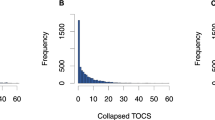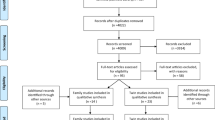Abstract
Although there is considerable evidence for a strong genetic component to idiopathic autism, several genome-wide screens for susceptibility genes have been carried out with limited concordance of linked loci, reflecting numerous genes of weak effect and/or sample heterogeneity. In the current study, linkage analysis was carried out in a sample of 62 autism-affected relative pairs with more severe obsessive–compulsive behaviors, selected from a larger (n=115) set of autism-affected relative pairs as a means of reducing sample heterogeneity. Obsessive–compulsive behaviors were assessed using the Autism Diagnostic Interview-Revised (ADI-R). In the sample with more severe obsessive–compulsive behaviors, multipoint NPL scores above 2 were observed on chromosomes 1, 4, 5, 6, 10, 11 and 19, with the strongest evidence for linkage on chromosome 1 at the marker D1S1656, where the multipoint NPL score was 3.06, and the two-point NPL score was 3.21. In follow-up analyses, analyzing the subset of families (n=35) where the patients had the most severe obsessive–compulsive behaviors generated a multipoint NPL score of 2.76, and a two-point NPL score of 2.79, indicating that the bulk of evidence for linkage was derived from the families most severely affected with obsessive–compulsive behaviors. The data suggest that there is an autism susceptibility gene on chromosome 1 and provide further support for the presence of autism susceptibility genes on chromosomes 6 and 19.
This is a preview of subscription content, access via your institution
Access options
Subscribe to this journal
Receive 12 print issues and online access
$259.00 per year
only $21.58 per issue
Buy this article
- Purchase on Springer Link
- Instant access to full article PDF
Prices may be subject to local taxes which are calculated during checkout



Similar content being viewed by others
References
Lord C, Rutter M, Le Couteur A . Autism Diagnostic Interview-Revised: a revised version of a diagnostic interview for caregivers of individuals with possible pervasive developmental disorders. J Autism Dev Disord 1994; 24: 659–685.
Rapin I, Katzman R . Neurobiology of autism. Ann Neurol 1998; 43: 7–14.
Bailey A, Le Couteur A, Gottesman I, Bolton P, Simonoff E, Yuzda E et al. Autism as a strongly genetic disorder: evidence from a British twin study. Psychol Med 1995; 25: 63–77.
Folstein S, Rutter M . Infantile autism: a genetic study of 21 twin pairs. J Child Psychol Psychiatry 1977; 18: 297–321.
Ritvo ER, Freeman BJ, Mason-Brothers A, Mo A, Ritvo AM . Concordance for the syndrome of autism in 40 pairs of afflicted twins. Am J Psychiatry 1985; 142: 74–77.
Steffenburg S, Gillberg C, Hellgren L, Andersson L, Gillberg IC, Jakobsson G et al. A twin study of autism in Denmark, Finland, Iceland, Norway and Sweden. J Child Psychol Psychiatry 1989; 30: 405–416.
Bolton P, Macdonald H, Pickles A, Rios P, Goode S, Crowson M et al. A case–control family history study of autism. J Child Psychol Psychiatry 1994; 35: 877–900.
Szatmari P, Jones MB, Zwaigenbaum L, MacLean JE . Genetics of autism: overview and new directions. J Autism Dev Disord 1998; 28: 351–368.
Pickles A, Bolton P, Macdonald H, Bailey A, Le Couteur A, Sim CH et al. Latent-class analysis of recurrence risks for complex phenotypes with selection and measurement error: a twin and family history study of autism. Am J Hum Genet 1995; 57: 717–726.
Risch N, Spiker D, Lotspeich L, Nouri N, Hinds D, Hallmayer J et al. A genomic screen of autism: evidence for a multilocus etiology. Am J Hum Genet 1999; 65: 493–507.
Pritchard JK . Are rare variants responsible for susceptibility to complex diseases? Am J Hum Genet 2001; 69: 124–137.
Spence MA . The genetics of autism. Curr Opin Pediatr 2001; 13: 561–565.
Gutknecht L . Full-genome scans with autistic disorder: a review. Behav Genet 2001; 31: 113–123.
Lamb JA, Moore J, Bailey A, Monaco AP . Autism: recent molecular genetic advances. Hum Mol Genet 2000; 9: 861–868.
Silverman JM, Smith CJ, Schmeidler J, Hollander E, Lawlor BA, Fitzgerald M et al. Symptom domains in autism and related conditions: evidence for familiality. Am J Med Genet 2002; 114: 64–73.
Spiker D, Lotspeich L, Kraemer HC, Hallmayer J, McMahon W, Petersen PB et al. Genetics of autism: characteristics of affected and unaffected children from 37 multiplex families. Am J Med Genet 1994; 54: 27–35.
MacLean JE, Szatmari P, Jones MB, Bryson SE, Mahoney WJ, Bartolucci G et al. Familial factors influence level of functioning in pervasive developmental disorder. J Am Acad Child Adolesc Psychiatry 1999; 38: 746–753.
Buxbaum JD, Silverman JM, Smith CJ, Kilifarski M, Reichert J, Hollander E et al. Evidence for a susceptibility gene for autism on chromosome 2 and for genetic heterogeneity. Am J Hum Genet 2001; 68: 1514–1520.
Shao Y, Raiford KL, Wolpert CM, Cope HA, Ravan SA, Ashley-Koch AA et al. Phenotypic homogeneity provides increased support for linkage on chromosome 2 in autistic disorder. Am J Hum Genet 2002; 70: 1058–1061.
IMGSAC . A genomewide screen for autism: strong evidence for linkage to chromosomes 2q, 7q, and 16p. Am J Hum Genet 2001; 69: 570–581.
Hollander E, King A, Delaney K, Smith CJ, Silverman JM . compulsive behaviors in parents of multiplex autism families. Psychiatry Res 2003; 117: 11–16.
Geschwind DH, Sowinski J, Lord C, Iversen P, Shestack J, Jones P et al. The autism genetic resource exchange: a resource for the study of autism and related neuropsychiatric conditions. Am J Hum Genet 2001; 69: 463–466.
Liu J, Nyholt DR, Magnussen P, Parano E, Pavone P, Geschwind D et al. A genomewide screen for autism susceptibility loci. Am J Hum Genet 2001; 69: 327–340.
Kruglyak L, Daly MJ, Reeve-Daly MP, Lander ES . Parametric and nonparametric linkage analysis: a unified multipoint approach. Am J Hum Genet 1996; 58: 1347–1363.
Vieland VJ, Hodge SE, Greenberg DA . Adequacy of single-locus approximations for linkage analyses of oligogenic traits. Genet Epidemiol 1992; 9: 45–59.
Durner M, Vieland VJ, Greenberg DA . Further evidence for the increased power of LOD scores compared with nonparametric methods. Am J Hum Genet 1999; 64: 281–289.
Greenberg DA, Abreu P, Hodge SE . The power to detect linkage in complex disease by means of simple LOD-score analyses. Am J Hum Genet 1998; 63: 870–879.
Smith CAB . Testing for heterogeneity of the recombination fraction values in human genetics. Ann Hum Genet 1963; 27: 175–182.
Durner M, Greenberg DA . Effect of heterogeneity and assumed mode of inheritance on lod scores. Am J Med Genet 1992; 42: 271–275.
Vieland VJ, Greenberg DA, Hodge SE . Adequacy of single-locus approximations for linkage analyses of oligogenic traits: extension to multigenerational pedigree structures. Hum Hered 1993; 43: 329–336.
Vieland V, Greenberg DA, Hodge SE, Ott J . Linkage analysis of two-locus diseases under single-locus and two-locus analysis models. Cytogenet Cell Genet 1992; 59: 145–146.
IMGSAC. A full genome screen for autism with evidence for linkage to a region on chromosome 7q. International Molecular Genetic Study of Autism Consortium. Hum Mol Genet 1998; 7: 571–578.
Le Couteur A, Bailey A, Goode S, Pickles A, Robertson S, Gottesman I et al. A broader phenotype of autism: the clinical spectrum in twins. J Child Psychol Psychiatry 1996; 37: 785–801.
Piven J, Palmer P, Jacobi D, Childress D, Arndt S . Broader autism phenotype: evidence from a family history study of multiple-incidence autism families. Am J Psychiatry 1997; 154: 185–190.
Philippe A, Martinez M, Guilloud-Bataille M, Gillberg C, Rastam M, Sponheim E et al. Genome-wide scan for autism susceptibility genes. Paris Autism Research International Sibpair Study. Hum Mol Genet 1999; 8: 805–812, Erratum in: Hum Mol Genet 1999; 8: 1353.
Auranen M, Nieminen T, Majuri S, Vanhala R, Peltonen L, Jarvela I . Analysis of autism susceptibility gene loci on chromosomes 1p, 4p, 6q, 7q, 13q, 15q, 16p, 17q, 19q and 22q in Finnish multiplex families. Mol Psychiatry 2000; 5: 320–322.
Millar JK, Wilson-Annan JC, Anderson S, Christie S, Taylor MS, Semple CA et al. Disruption of two novel genes by a translocation co-segregating with schizophrenia. Hum Mol Genet 2000; 9: 1415–1423.
Blackwood D H, Fordyce A, Walker M T, St Clair D M, Porteous D J, Muir W J . Schizophrenia and affective disorders—cosegregation with a translocation at chromosome 1q42 that directly disrupts brain-expressed genes: clinical and P300 findings in a family. Am J Hum Genet 2001; 69: 428–433.
Ozeki Y, Tomoda T, Kleiderlein J, Kamiya A, Bord L, Fujii K et al. Disrupted-in-Schizophrenia-1 (DISC-1): mutant truncation prevents binding to NudE-like (NUDEL) and inhibits neurite outgrowth. Proc Natl Acad Sci USA 2003; 100: 289–294.
Shao Y, Cuccaro ML, Hauser ER, Raiford KL, Menold MM, Wolpert CM et al. Fine mapping of autistic disorder to chromosome 15q11–q13 by use of phenotypic subtypes. Am J Hum Genet 2003; 72: 539–548.
Millet B, Chabane N, Delorme R, Leboyer M, Leroy S, Poirier MF et al. Association between the dopamine receptor D4 (DRD4) gene and obsessive–compulsive disorder. Am J Med Genet 2003; 116B: 55–59.
Hanna GL, Veenstra-VanderWeele J, Cox NJ, Boehnke M, Himle JA, Curtis GC et al. Genome-wide linkage analysis of families with obsessive–compulsive disorder ascertained through pediatric probands. Am J Med Genet 2002; 114: 541–552.
Zhang H, Leckman JF, Pauls DL, Tsai CP, Kidd KK, Campos MR . Tourette Syndrome Association International Consortium for Genetics. Genomewide scan of hoarding in sib pairs in which both sibs have Gilles de la Tourette syndrome. Am J Hum Genet 2002; 70: 896–904.
Acknowledgements
This work was supported by the Seaver Autism Research Center and Cure Autism Now, as well as by the National Institute of Mental Health through a STAART grant (U54 MH 066673). We thank AGRE and Dr T Conrad Gilliam for the genotyping data, all of which were performed in the laboratory of Dr Gilliam and can be found on the AGRE website (www.agre.org).
Author information
Authors and Affiliations
Corresponding author
Rights and permissions
About this article
Cite this article
Buxbaum, J., Silverman, J., Keddache, M. et al. Linkage analysis for autism in a subset families with obsessive–compulsive behaviors: Evidence for an autism susceptibility gene on chromosome 1 and further support for susceptibility genes on chromosome 6 and 19. Mol Psychiatry 9, 144–150 (2004). https://doi.org/10.1038/sj.mp.4001465
Received:
Revised:
Accepted:
Published:
Issue Date:
DOI: https://doi.org/10.1038/sj.mp.4001465
Keywords
This article is cited by
-
Bio-collections in autism research
Molecular Autism (2017)
-
Essential role of the nuclear isoform of RBFOX1, a candidate gene for autism spectrum disorders, in the brain development
Scientific Reports (2016)
-
Role of the cytoplasmic isoform of RBFOX1/A2BP1 in establishing the architecture of the developing cerebral cortex
Molecular Autism (2015)
-
Variants of the CNTNAP2 5′ promoter as risk factors for autism spectrum disorders: a genetic and functional approach
Molecular Psychiatry (2015)
-
Identification of rare DNA sequence variants in high-risk autism families and their prevalence in a large case/control population
Molecular Autism (2014)



